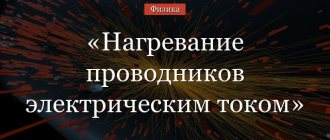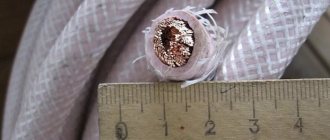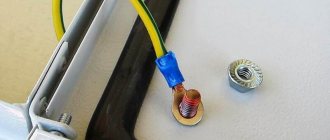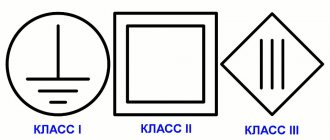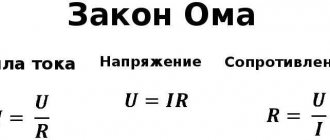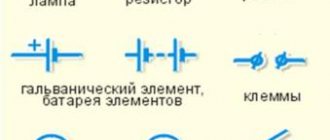Modern people are accustomed to the fact that by plugging in an iron, a table lamp or a regular boiler, the equipment will immediately begin to release thermal energy and light. According to what law of physics does this action occur? James Joule and Emil Lenz managed to explain this. The result of their research was called the Joule-Lenz law. In practice, he helped achieve great discoveries in electromechanics.
Content
When current passes through a conductor, one can observe its various effects: thermal, chemical, magnetic or light. The thermal effect of current is manifested in the fact that the medium in which it flows heats up. It can manifest itself in both solids and liquids and gases.
In this lesson we will take a closer look at the thermal effect of current, analyze the physics of the processes taking place and get acquainted with the Joule-Lenz law . This law will allow us to find out which conductors heat up more than others and what determines the amount of energy that goes into heating.
Physical meaning
Let's remember how electric current flows through a metal conductor. As soon as the electrical circuit is closed, under the influence of EMF, the movement of free electrons is ordered, and they rush to the positive pole of the power source. However, on their way there are orderly rows of crystal lattices, the atoms of which create obstacles to ordered movement, that is, they offer resistance.
Part of the energy of moving electrons is spent on overcoming resistance. In accordance with the fundamental law of conservation of energy, it cannot disappear without a trace. This is what turns into heat, causing the conductor to heat up. The accumulated thermal energy is radiated into the surrounding space or heats other objects in contact with the conductor.
Figure 2 shows a diagram of an experiment demonstrating the law of the thermal effect of current heating a section of wire in an electrical circuit.
Rice. 2. Thermal effect of current
The phenomenon of heating conductors has been known almost since the creation of electric current, but researchers could not then explain its nature, much less propose a way to estimate the amount of heat generated. This problem is solved by the Joule-Lenz law, which we use to this day.
Practical benefits of the Joule-Lenz law
When heated strongly, one can observe the emission of the visible spectrum of light, which occurs, for example, in an incandescent light bulb. Weakly heated bodies also emit thermal energy, but in the range of infrared radiation, which we do not see, but can feel with our thermal receptors.
It is impossible to allow the conductors to become very hot, since excessive temperature destroys the structure of the metal, in other words, it melts it. This can lead to damage to electrical equipment and may also cause a fire. In order to prevent critical heating parameters, it is necessary to make calculations of thermal elements using formulas describing the Joule-Lenz law.
Having analyzed the expression U 2 /R , we are convinced that when the resistance tends to zero, the amount of heat released tends to infinity. This situation occurs during short circuits. This is the main danger of short circuit.
To combat short circuits use:
- circuit breakers:
- electronic protective units;
- fuses;
- other protective devices.
Heating of a conductor when an electric current passes through it
How can we explain the heating of a conductor by electric current?
When electric current passes through a conductor, its temperature increases - it heats up. What happens inside the conductor?
Under the influence of an electric field, an electric current arises in a metal conductor. Free electrons begin to move in an orderly manner. At the same time, the chaotic nature of their movement is preserved .
With this movement, they (free electrons) interact with ions located in the nodes of the crystal lattice of the conductor. During this interaction, free electrons transfer their kinetic energy to the ions. For example, this happens when colliding with them.
Thus, the energy of the electric field is converted into the internal energy of the conductor. His temperature increases.
When electric current flows through a conductor, its internal energy increases.
In solutions of salts, acids, and alkalis, free charged particles are ions. They will also interact with the atoms of the substance.
Why does the conductor get hot?
How is the heating of the conductor explained? Why does it heat up and not remain neutral or cool down? Heating occurs due to the fact that free electrons moving in a conductor under the influence of an electric field bombard the atoms of metal molecules, thereby transferring to them their own energy, which turns into heat. To put it quite simply: when overcoming the material of the conductor, the electric current seems to “rub”, colliding with electrons against the molecules of the conductor. Well, as you know, any friction is accompanied by heating. Consequently, the conductor will heat up while electric current runs through it.
It also follows from the formula that the higher the resistivity of the conductor and the higher the current flowing through it, the higher the heating will be. For example, if you connect a copper conductor (resistivity 0.018 Ohm mm²/m) and an aluminum conductor (0.027 Ohm mm²/m) in series, then when electric current flows through the circuit, aluminum will heat up more than copper due to its higher resistance . Therefore, by the way, it is not recommended to twist copper and aluminum wires together in everyday life - there will be uneven heating at the point of twisting. The result is burning with subsequent loss of contact.
What determines the amount of heat released by a current-carrying conductor?
An electric current passes through a conductor. It's heating up. At the same time, it is in contact with the environment, and is not in a vacuum. For this reason, the conductor begins to release a certain amount of heat $Q$. That is, the conductor interacts with the environment through heat transfer.
Looking inside the conductor and explaining its heating, we can assume that the amount of heat depends on at least two quantities: resistance and current .
Let's figure out why we chose these particular values.
- Resistance The greater the resistance of a conductor, the more it prevents the passage of electric current. This means that the stronger the ions in the metal interact with free electrons and the more energy they receive. This means that when current passes through a conductor with high resistance, a large amount of heat should be released. We assume that the resistance of the conductor is directly proportional to the amount of heat generated.
- Current strength Current strength is calculated by the formula: $I = \frac{q}{t}$. It turns out that the greater the current, the greater the number of free particles passing through the cross section of the conductor per unit time. This means that more collisions occur with the ions and atoms of the conductor. Consequently, the greater the amount of heat that is released when electric current passes through the conductor.
Dependence of the amount of heat released in a conductor on its resistance
Let's empirically confirm our first assumption. Let's assemble an electrical circuit consisting of two heaters and a current source. Let's connect all the elements in series.
Our heaters have the same dimensions, but are made of different materials. Accordingly, they have different resistances $R_1$ and $R_2$ . Moreover, $R_1 > R_2$.
Let's lower the heaters into calorimeters (instruments for measuring the amount of heat) with the same amount of water. The initial temperature of the water in both vessels is also the same.
Let's close the circuit. Electric current now flows through the heaters (Figure 1). The current strength in them is the same because they are connected in series.
Figure 1. Dependence of the amount of heat released in a conductor on its resistance
We will see that the water will heat up faster in the first calorimeter. This means that she received more heat. It is in this calorimeter that we have a heater with a high resistance $R_1$. Our assumption was confirmed.
The greater the resistance of the conductor, the greater the amount of heat released when electric current passes through it.
Dependence of the amount of heat released in a conductor on the current strength in it
Now let's check our second assumption. Let's assemble an electrical circuit consisting of an incandescent lamp, a rheostat, an ammeter and a current source.
By moving the rheostat slider, we will gradually increase the current in the circuit. We will see that the brightness of the light bulb will increase (Figure 2).
Figure 2. Dependence of the amount of heat released in the conductor on the current strength in it
It turns out that as the current increases, the amount of heat released by the filament of the lamp increases. Assumption No. 2 is confirmed.
The greater the current strength in the conductor, the greater the amount of heat released when electric current passes through it.
EXAMPLES OF TASKS
Part 1
1. The current strength in the conductor was increased by 2 times. How will the amount of heat released in it per unit time change if the resistance of the conductor remains constant?
1) will increase by 4 times 2) will decrease by 2 times 3) will increase by 2 times 4) will decrease by 4 times
2. The length of the electric stove spiral was reduced by 2 times. How will the amount of heat released in the spiral per unit time change at a constant network voltage?
1) will increase by 4 times 2) will decrease by 2 times 3) will increase by 2 times 4) will decrease by 4 times
3. The resistance of the resistor \( R_1 \) is four times less than the resistance of the resistor \( R_2 \). Current work in resistor 2
1) 4 times more than in resistor 1 2) 16 times more than in resistor 1 3) 4 times less than in resistor 1 4) 16 times less than in resistor 1
4. The resistance of the resistor \( R_1 \) is 3 times greater than the resistance of the resistor \( R_2 \). The amount of heat that will be released in resistor 1
1) 3 times more than in resistor 2 2) 9 times more than in resistor 2 3) 3 times less than in resistor 2 4) 9 times less than in resistor 2
5. The circuit is assembled from a current source, a light bulb and a thin iron wire connected in series. The light bulb will glow brighter if
1) replace the wire with a thinner iron one 2) reduce the length of the wire 3) swap the wire and the light bulb 4) replace the iron wire with nichrome
6. The figure shows a bar graph. It shows the voltage values at the ends of two conductors (1) and (2) of the same resistance. Compare the values of current work \( A_1 \) and \( A_2 \) in these conductors for the same time.
1) \( A_1=A_2 \) 2) \( A_1=3A_2 \) 3) \( 9A_1=A_2 \) 4) \( 3A_1=A_2 \)
7. The figure shows a bar graph. It shows the current values in two conductors (1) and (2) of the same resistance. Compare the values of current work \( A_1 \) and \( A_2 \) in these conductors for the same time.
1) \( A_1=A_2 \) 2) \( A_1=3A_2 \) 3) \( 9A_1=A_2 \) 4) \( 3A_1=A_2 \)
8. If you use lamps with a power of 60 and 100 W in a chandelier to illuminate the room, then
A. A large current will be in a 100 W lamp. B. A 60 W lamp has greater resistance.
The following statement(s) are true:
1) only A 2) only B 3) both A and B 4) neither A nor B
9. An electric stove connected to a direct current source consumes 108 kJ of energy in 120 s. What is the current strength in the tile spiral if its resistance is 25 Ohms?
1) 36 A 2) 6 A 3) 2.16 A 4) 1.5 A
10. An electric stove with a current of 5 A consumes 1000 kJ of energy. What is the time it takes for the current to pass through the spiral of the tile if its resistance is 20 Ohms?
1) 10000 s 2) 2000 s 3) 10 s 4) 2 s
11. The nickeline spiral of the electric stove was replaced with a nichrome one of the same length and cross-sectional area. Establish a correspondence between physical quantities and their possible changes when the tile is connected to the electrical network. Write down the selected numbers in the table under the corresponding letters. The numbers in the answer may be repeated.
PHYSICAL QUANTITY A) electrical resistance of the spiral B) electric current strength in the spiral B) electric current power consumed by the tile
NATURE OF CHANGE 1) increased 2) decreased 3) did not change
12. Establish a correspondence between physical quantities and the formulas by which these quantities are determined. Write down the selected numbers in the table under the corresponding letters.
PHYSICAL QUANTITIES A) current work B) current strength C) current power
FORMULAS 1) \( \frac{q}{t} \) 2) \( qU \) 3) \( \frac{RS}{L} \) 4) \( UI \) 5) \( \frac{U}{I} \)
Part 2
13. The heater is connected in series with a rheostat with a resistance of 7.5 Ohms in a network with a voltage of 220 V. What is the resistance of the heater if the power of the electric current in the rheostat is 480 W?
Joule-Lenz law
Similar experiments were carried out by two scientists at the same time, but independently of each other. One of them is James Joule , and the second is the Russian physicist Emilius Christianovich Lenz (Figure 3).
Figure 3. Emilius Lenz (1804-1865) - Russian physicist, one of the founders of electrical engineering
By analyzing the quantities measured during the experiments, scientists were able to mathematically formulate a law describing the amount of heat released by a conductor when an electric current passes through it.
Joule-Lenz Law: The amount of heat released by a current-carrying conductor is equal to the product of the square of the current, the resistance of the conductor and time; $Q = I^2Rt$.
We can get the same result by performing simple mathematical operations with quantities already known to us. But for this, we only have to look at one nuance - the law of conservation of energy when a conductor is heated by current.
Lenz's experiments
Let's fast forward to the 19th century, the era of accumulation of knowledge and preparation for the technological leap of the 20th century. An era when all over the world various scientists and simply self-taught inventors discover something new almost every day, often spending a huge amount of time on research and, at the same time, not presenting the final result.
One of these people, the Russian scientist Emilius Christianovich Lenz, was fascinated by electricity, at the then primitive level, trying to calculate electrical circuits. In 1832, Emilius Lenz was “stuck” with calculations, since the parameters of his simulated circuit “energy source - conductor - energy consumer” varied greatly from experiment to experiment. In the winter of 1832-1833, the scientist discovered that the cause of the instability was a piece of platinum wire that he brought from the cold. When heating or cooling a conductor, Lenz also noticed that there was a certain relationship between the current strength, electrical resistance and temperature of the conductor.
At certain parameters of the electrical circuit, the conductor quickly thawed and even warmed up slightly. There were practically no measuring instruments in those days - it was impossible to accurately measure either current or resistance. But this was a Russian physicist, and he showed ingenuity. If this is an addiction, then why shouldn't it be reversible?
In order to measure the amount of heat generated by the conductor, the scientist designed a simple “heater” - a glass container in which there was an alcohol-containing solution and a platinum spiral conductor immersed in it. By applying different amounts of electric current to the wire, Lenz measured the time it took for the solution to heat up to a certain temperature. Sources of electric current in those days were too weak to heat the solution to a serious temperature, so it was not possible to visually determine the amount of evaporated solution. Because of this, the research process was very drawn out - thousands of options for selecting the parameters of the power source, conductor, long measurements and subsequent analysis.
Law of conservation of energy when heating a conductor with current
According to the law of conservation of energy, we know that energy does not come from nowhere and does not go to nowhere.
Where did we get some additional energy in the conductor that went to heat it? This is the energy of the electric field created by the current source. If the field has some energy, then it can do some work, which is what happens in practice. At the same time, our conductor heats up and receives a certain amount of heat (energy). It turns out that electrical energy is converted into internal energy of the body .
If the current produces only a thermal effect, then the amount of heat released in the conductor will be equal to the work done by the electric current during this time: $Q = A$.
Kirchhoff's laws
Kirchhoff's laws establish the relationship between currents and voltages in electrical circuits. Kirchhoff's laws are of particular importance in electrical engineering because of their versatility, as they are suitable for solving any electrical problems.
Kirchhoff's first law states that the algebraic sum of the currents at any node in any circuit is equal to zero.
Or in other words, the sum of all currents flowing into a node is equal to the sum of all currents flowing out of the node.
Let's consider Kirchhoff's first law using an example:
Here I2 and I4 are incoming currents, and I1 and I3 are outgoing currents
Then, according to Kirchhoff’s rule, we can write:
I1 + I2 - I3 +I4 = 0 or I2 + I4 = I1+ I3
Kirchhoff's second law states that the algebraic sum of the voltage drops along any closed circuit circuit is equal to the algebraic sum of the emf acting along the same circuit.
In other words, when completely bypassing the circuit, the potential, changing, returns to its original value. A special case of the second rule for a circuit consisting of one circuit is Ohm's law for this circuit.
When drawing up a stress equation for a circuit, you need to choose the positive direction of traversing the circuit. In this case, the voltage drop on the branch is considered positive if the direction of bypass of this branch coincides with the previously selected direction of the branch current, and negative otherwise.
Kirchhoff's rules are valid for linear and nonlinear circuits for any type of change in currents and voltages over time.
Mathematical derivation of the Joule-Lenz law
Heating during the passage of electric current occurs in stationary metal conductors. It turns out that the work of the current will go to increase the internal energy of the conductor. The heated conductor will transfer this energy to surrounding bodies by heat transfer: $Q = A$.
The work done by electric current is calculated by the formula: $A = UIt$. Then $Q = A = UIt$.
Let's express the voltage through Ohm's law: $I = \frac{U}{I}$, $U = IR$.
Let's substitute this expression into the formula for the amount of heat: $Q = UIt = IR \cdot It = I^2Rt$.
We have arrived at the correct recording of the Joule-Lenz law.
Pros and cons of electric heating
- Pros . Heating of conductors with electric current finds its application in various useful appliances and devices: electric stoves, kettles, coffee makers, boilers, hair dryers, irons, heaters.
- Minuses . Very often, electronics engineers have to deal with this effect in order, for example, to ensure the functionality of electronic boards, which are stuffed with a huge number of electronic parts, microcircuits, etc. All these elements heat up in accordance with the Joule-Lenz law. And if measures are not taken for forced cooling using metal radiators or fans (coolers), then the boards will quickly fail from overheating.
2. Household heating appliances: kettle, iron, hair dryer, electric stove. Often, to quickly connect wires, many people use the “twisting” method. This leads to a significant increase in resistance, and therefore, the “twisted” area will heat up more than the rest of the wiring. Therefore, twisting of wires often causes fires in houses and apartments. To improve contact, you need to solder this place well.
Exercises
Exercise No. 1
How much heat will be released in $30 \space min$ by a wire spiral with a resistance of $20 \space Ohm$ at a current strength of $5 \space A$?
Given: $t = 30 \space min$ $R = 20 \space Ohm$ $I = 5 \space A$
SI: $t = 1800 \space s$
$Q — ?$
Show solution and answer
Hide
Solution:
We use the Joule-Lenz law: $Q = I^2Rt$.
$Q = 5^2 \space A^2 \cdot 20 \space Ohm \cdot 1800 \space c = 900 \space 000 \space J = 900 \space kJ$.
Answer: $Q = 900 \space kJ$.
Exercise No. 2
For what purpose are the wires at the junction points not only twisted, but also soldered?
Justify your answer. By twisting one conductor with another, we get a thickened and compacted junction. The resistance in such a section will be greater than that of the wires themselves. And the greater the resistance of the conductor, the more heat will be generated when electric current passes through it. This area will become very hot.
Soldering allows you to make the junction of the wires more uniform. This practically does not change the resistance. This way we avoid heating the wires where they connect to each other.
Exercise #3
The spiral of the heating device - the reflector - is connected to the socket using a cord and plug.
The cord consists of wires that supply current to the spiral, covered with insulation. The spiral and wires are connected in series. How is the voltage supplied from the network distributed between the wires and the spiral? Why does the spiral heat up, but the wires hardly heat up? What features of the spiral and wire design achieve this difference? We will rely on the Joule-Lenz law: $Q = I^2Rt$.
The spiral gets hot, but the wires don’t. This means that much more heat $Q$ is released on the spiral than in the wires. If the current is the same, then the reason for this is the resistance $R$.
Therefore, we conclude that the spiral is heated, since it has much greater resistance than wires . This device is determined by the materials from which the spiral and wires are made. The resistivity of the spiral is exactly greater than the resistivity of the wires ($R = \frac{\rho l}{S})$. Also, the wires are thinner than the spiral. Their cross-sectional area is much smaller than the cross-sectional area of the heating device spiral. Therefore, less heat is generated in the wires than in the spiral.
What will happen to the voltage in such a circuit? Let's write the Joule-Lenz law in this form: $Q = UIt$. It is said that all the elements in this circuit are connected in series. This means that the current strength $I$ in all its sections will be the same.
It turns out that the voltage on the spiral will be greater than the voltage at the ends of the wires .
Practical significance
Ohm's law for alternating current
It is clear that the amount of heat generated depends on the current density and conductivity of a particular substance. The corresponding influences can be clearly recorded by successively passing a current of 2 and 50 A through a control copper conductor with a cross-section of 2 mm2. In the second experiment, the heating will be much stronger. It can be reduced by increasing the diameter of the conductor.
Reduced energy loss
This example demonstrates an undesirable phenomenon for power lines. Using part of the energy to heat the surrounding space increases the losses of overhead lines. Exceeding the threshold value provokes the destruction of veins and protective shells. Excessive temperature increases are the cause of fires.
Similar phenomena occur if excessive current is selected or the cross-section of the conductor is insufficient. The amount of heat generated in the line is inversely proportional to the square of the voltage (U) at the connected consuming device. By increasing U, losses can be reduced. However, such an action increases the likelihood of a short circuit and worsens the overall safety parameters.
Choosing wires for circuits
The thermal destruction problems noted above largely depend on the resistivity (Ry). For clarity, you can use materials with significantly different characteristics.
Experiment with different conductors
Calculations of the amount of heat ( Q , J) for samples 1 m long with a cross section of 1 mm square. with a current of 5A for 30 seconds:
- copper – 12.75;
- steel – 75;
- nickel – 315.
Particular attention should be paid to the parameters of power cables, which must maintain integrity during actual operation. As a rule, household lines are installed deep in building structures. This method implies good protection from adverse external influences. At the same time, the costs of correcting errors and eliminating the consequences of accidents are increasing.
To use cable products correctly, you should be guided by thematic standards that are set out in the PUE. To simplify the choice, specialized tables are offered that show the calculation results taking into account the following important factors:
- type of insulation;
- duration and magnitude of overloads;
- gasket features.
Correction factors that take into account the increase in resistance with increasing temperature are separately considered in the PUE. This phenomenon is explained by an increase in the vibration frequency of atoms, which creates additional obstacles to electric current.
Example:
- the conductor is heated with a rated current of 7 A to +50°C at an ambient temperature of +25°C;
- select suitable products taking into account real conditions;
- if the cable will be used outdoors, where the temperature rises to +45°C, use a coefficient of 0.45 (the permissible current is reduced I=7*0.45=3.15 A);
- in cold weather (-5°C) choose a different correction factor:
I=7*1.48= 10.36 A.
You can speed up your selection using pivot tables. They show the permissible currents for copper (aluminum) conductors with a standardized cross-section.
Electric heating devices
Taking into account the same amount of current in any part of a single circuit, it is possible to create a design for deliberate heating of a certain zone. Here a conductor with high resistivity is installed or the cross-sectional area is reduced. An accurate calculation will help eliminate temperature increases to a critical level that destroys the product.
Power supply conductors are selected based on the principles outlined in the previous section. They must not overheat excessively under the operating conditions specified in the plan.
Fuses
Thermal circuit break is used to protect equipment and consumers if the current exceeds the rated value. Specialized devices (fuses) are made of lead, steel, and other metals and alloys. Under normal operating conditions, heat is dissipated and does not cause damage. Once the threshold values are reached, the resistance and temperature increase significantly. At a certain level, the element is destroyed and the power source is simultaneously turned off.
Fuses are evaluated by a complex parameter (K) using the formula:
K=t*I2,
Where:
- I – threshold current value;
- t is the maximum destruction time.
Disposable, inexpensive products in this category are designed for relatively low currents (0.25-2 A). The typical design is a thin wire in a quartz glass tube with contacts for mounting on a circuit board. Such fuses are installed in radio equipment to protect individual circuits. A visual check can quickly determine the integrity of the fuses.
Inserts designed for high currents are placed in sand or other special medium. This solution prevents the formation of plasma and ensures rapid chain breaking. In some modifications, the fuse housing is made of special materials that generate gas when heated strongly. It speeds up arc extinction. Mechanisms are also used that increase the distance between the contact terminals in the event of emergency situations.
For your information. For high-current circuits, fuses with replaceable inserts are produced.
Application of the thermal effect of electric current
The thermal effect of electric current is used in heating elements:
- heating devices;
- boilers;
- irons;
- washing machines and dishwashers;
- kettles, coffee makers.
Using a special cable, they prevent freezing of pipes and the formation of ice on thresholds. Heat guns quickly raise the temperature in large rooms and speed up plastering work.
It should be noted that the use of electric convectors is promising in comparison with classic heating radiators:
- simplicity;
- compactness;
- light weight;
- durability;
- good compatibility with the latest control and monitoring systems of the “smart home” category.
Separately, the high level of security should be noted. Protection of high-current circuits can be provided by cheap fuses. This is much cheaper and more reliable compared to a set of measures to prevent the formation of a gas mixture.
In standard fuses, in addition to digital designations, the rated current is indicated by colored marks
The thermal effect does not always perform useful functions. Outdated incandescent lamps, for example, waste a significant part of their energy on uselessly heating the surrounding space. Economical gas-discharge and LED devices work much more efficiently.

